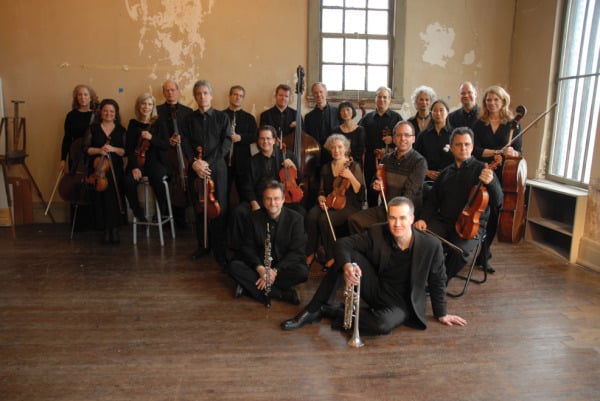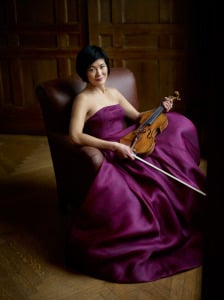
The world-renowned Orpheus Chamber Orchestra, founded in 1972, took the stage with violinist Jennifer Koh last Saturday. Known for its democratic approach to music-making – Orpheus lacks a traditional conductor, instead opting for a rotating leadership group – it aims to “combine the intimacy and warmth of a chamber ensemble with the richness of the orchestra,” according to the program notes. In this concert, Orpheus paired up with Koh, the 1994 winner of the prestigious International Tchaikovsky Competition, for a diverse selection of works spanning the 18th century to 2014. The majority of the program featured a 13-member string section along with a harpsichord in J.S. Bach’s Violin Concerto in A minor. The winds and percussionists then joined them onstage for Mozart’s Symphony No. 34 in C major, K. 338.
If one could sum up the performance in three words, they would be clarity, precision and articulation. The collaboration among members was impressive; each individual, focused on his or her own part, was also finely attuned to the overall musical landscape. Stealing quick, knowing glances with each other, they used exaggerated body language – nodding, swaying, lifting their bows – to signal cadences, entrances and arrivals throughout each piece.
Synchronization was key, and they nailed it. Plunging into the opening notes of the “Praeludium” from Edvard Grieg’s suite, “From Holberg’s Time,” Op. 40, the strings buzzed with musical anticipation, their articulated accents and precise pizzicato showcasing their extraordinary technical unity. But more importantly, Orpheus boasted artistic cohesion, remaining together through the broad fortissimos, delicate pianissimos and everything in between. The ritardando at the end of the “Praeludium,” in which the orchestra slowed down together with grand – and finely timed – emphasis further illustrated its exceptional coordination.
Orpheus carried these traits through the remaining suite. In the “Sarabande,” the orchestra employed smooth expressive rubato phrasing, sailing through the lively “Gavotte” and into the somber “Air.” The final movement, “Rigaudon,” featured prominent roles for the first violin and viola as they zig-zagged through the piece, subsiding temporarily for a sweet French melody, only to resume again for a rousing finish.
Next, Koh joined forces with Orpheus for an elegant rendition of the Bach concerto. Standing amid the orchestra in a magnificent magenta strapless dress, she dived into the first movement with gusto, the strings following not far behind. In the “Andante,” the gentle lilting of the cellos supported expressive legato phrases as Koh, eyes closed and face tilted upwards, gauged the exact amount of pressure that would draw out the sweet, warm timbres of this emotional movement. Next came the fiery “Allegro Assai,” in which Koh led the orchestra, with assertive playfulness, to a triumphant conclusion.

Koh remained center stage to perform the world premiere of Anne Clyne’s “Rest These Hands.” It began with a barely audible drone from the bass as Koh entered with an exotic, haunting melody. The tension between the two lines was almost palpable, clashing with dissonance. A substantial violin cadenza in the middle of the work, with arpeggiated chords, double-stops, slides and scales showed off Koh’s remarkable technical ability and artistic finesse. Later, other strings slipped in, creating a quiet cacophony of murmurs, chatters and whispers, above which Koh’s violin soared with its long, piercing tones. Meanwhile, as the music progressed, the stage lights gradually dimmed, illuminating Koh’s figure against the dark backdrop of chromatic harmonies and ominous undertones. In the last line, notes clashed then fused together, melting away into soft silence.
The final piece on the program, Mozart’s Symphony No. 34 in C Major K. 338, was quick to dissipate the solemnity of Clyne’s composition. Once again, Orpheus brought impressive clarity to the work with its crisp bowings and clean scales, both of which reflected precision in technique, tone and character. Its interpretation of this three-movement symphony successfully highlighted the whimsical moods of Mozart — capricious, charming, pompous and tender. The third movement provided a thrilling conclusion to the concert as the strings raced breathlessly toward the end, relenting occasionally for bright commentary by the winds. After the last resounding chords, the audience offered a partial standing ovation as the performers filed off stage.
Walking out of the auditorium, I was incredulous at how this orchestra with more than 20 members moved in such a cohesive unit through the long Romantic phrases of Grieg and the intricacies of Bach, as well as how it expressed a wide range of emotional colors and intensities with versatility. And incredibly, all this was without a conductor! Whether or not this means that classical music is becoming more democratic, one only has to listen to the Orpheus Chamber Orchestra to realize that whatever it is, it’s surely a good thing.
Contact Marisa Lin at mlin3 ‘at’ stanford.edu.
